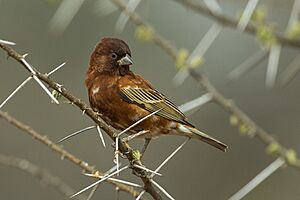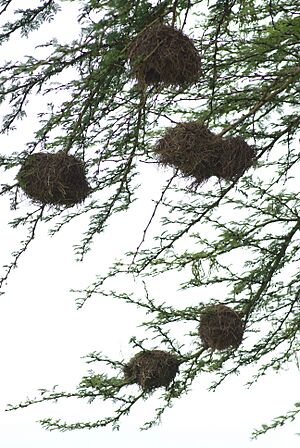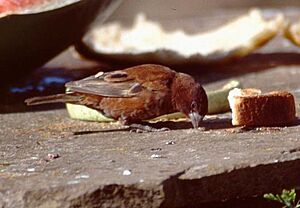Chestnut sparrow facts for kids
Quick facts for kids Chestnut sparrow |
|
|---|---|
 |
|
| Male in breeding plumage in Kenya | |
| Conservation status | |
| Scientific classification | |
| Synonyms | |
|
The chestnut sparrow (Passer eminibey) is a tiny bird from the sparrow family. It's the smallest sparrow, growing to about 11 cm (4.3 in) long. Males in breeding season have bright chestnut (reddish-brown) feathers. Females and young birds are duller grey with some chestnut spots.
Like its close relatives, the Arabian golden sparrow and the Sudan golden sparrow, it likes to live in groups. You can find these birds in dry areas across eastern Africa, from Sudan to Tanzania. They live in dry savanna (grasslands with scattered trees), papyrus swamps, and even near people. Both adult and young chestnut sparrows mostly eat grass seeds. They fly in flocks, often with other bird species, to find food. They build their own dome-shaped nests in trees, but sometimes they take over the fancy nests of weavers.
Contents
About the Chestnut Sparrow's Name

This sparrow was first described in 1880 by a scientist named Gustav Hartlaub. He named it Emini Bey to honor the explorer Emin Pasha. Emin Pasha collected the first example of this bird in what is now South Sudan or Uganda. Because of this, the bird is sometimes called Emin Bey's sparrow.
Scientists usually place the chestnut sparrow in the Passer genus, which includes many other sparrows. It looks very similar to the two golden sparrows. The male Arabian golden sparrow is almost all gold. The male chestnut sparrow is mostly chestnut. The male Sudan golden sparrow is somewhere in between. These three species act very similarly, especially in how they deal with their dry homes.
What Does the Chestnut Sparrow Look Like?

Like other sparrows, the chestnut sparrow is a small, plump songbird. It has a thick beak, which is perfect for eating seeds. It's the smallest sparrow, measuring between 10.5 to 11.5 cm (4.1–4.5 in) long. It weighs about 12 grams (0.42 oz) to 17 grams (0.60 oz).
Male and Female Plumage
The male chestnut sparrow in breeding season has deep chestnut feathers. It also has black on its face, wings, and tail. It's hard to confuse the breeding male with other birds, except for the chestnut weaver. However, the chestnut weaver is much bigger and has white on its wings. The male's legs and feet are a pale grey color.
When not breeding, the male chestnut sparrow has white spots on its upper body. Much of its feathers are a dull yellow or whitish with chestnut crescent shapes. As these dull feathers wear off, the bright chestnut breeding feathers show through.
Female chestnut sparrows have similar feather patterns to males, but their colors are not as bright. The female has a grey head, a dull yellow stripe above her eye, and a dull yellow chin and throat. Her upper body is black and warm brown, and her belly is off-white.
Young Sparrows
Young chestnut sparrows are dull grey with a brown back. They have a pale yellow stripe above their eye. Females and young birds have hints of chestnut on their stripe, shoulders, and throat. This helps tell them apart from other sparrows in the same areas.
Its Calls
The basic sound of the chestnut sparrow is a soft chirp. They have a scolding call that sounds like chrrrrit. Their flight call sounds like chew chew. When males are trying to attract a mate, they make a high, twittering trill, like tchiweeza tchiweeza tchi-tchi-tchi-tchi- see-see-see-seeichi.
Where Does the Chestnut Sparrow Live?
The chestnut sparrow lives in East Africa. You can find it in lower areas from Sudan, through Somalia, Uganda, and Kenya, all the way to north-central Tanzania. Its range also goes into parts of Ethiopia.
Like the golden sparrows, it sometimes moves around when it's not breeding. Some birds have been seen far from their usual homes, like in Dar es Salaam. It mostly lives in dry savannas, fields, and villages. But unlike its golden sparrow relatives, it can also be found in papyrus swamps. Scientists haven't counted all of them, but they seem common across a very large area. Because of this, the IUCN Red List says they are of "Least Concern" for global extinction.
How Does the Chestnut Sparrow Behave?
Chestnut sparrows love to be in groups. You rarely see them alone. They often hang out with other birds like queleas and weavers. Adult sparrows eat grass seeds. If they live near people, they will also eat crumbs and other food scraps. Baby sparrows are fed softer grass seeds and small beetles.
Building Nests and Raising Young

The nesting habits of the chestnut sparrow are interesting. Early reports said they built typical sparrow nests in trees. Later, some thought they built fancy nests like weavers.
In 1967, a scientist named Robert B. Payne studied chestnut sparrows. He found that they often took over the nests of grey-capped social weavers. These weavers build very detailed nests. Payne thought that chestnut sparrows might always use other birds' nests. However, we now know that chestnut sparrows also build their own nests. Their own nests are messy, dome-shaped structures made of grass and lined with feathers.
Their breeding season changes depending on the area and when it rains. It also depends on when their host birds (like the weavers) are breeding. Because of this, chestnut sparrows have been seen breeding in every month of the year across their range.
During Payne's study, the sparrows started looking for mates when the weavers began building their nests. Male sparrows would display around the new weaver nests. They would crouch, raise and shake their wings, and make a high, twittering trill. The weavers would chase the sparrows away, but the sparrows would keep coming back. When a female sparrow came near a displaying male, he would shake his wings faster, spread his tail, and bow his head. This special dance helps pairs form and keeps the birds together in their colony.
Males and mated pairs would bother the social-weavers while they were building. They would keep going until the weavers left their nests. Fights between the two species were common. After the sparrows took over, the female would lay her eggs. A clutch usually has three or four eggs. They are oval-shaped and can be white or bluish-white. In captivity, the eggs hatch in 18 to 19 days. Some observations show that only the female feeds the baby birds.



